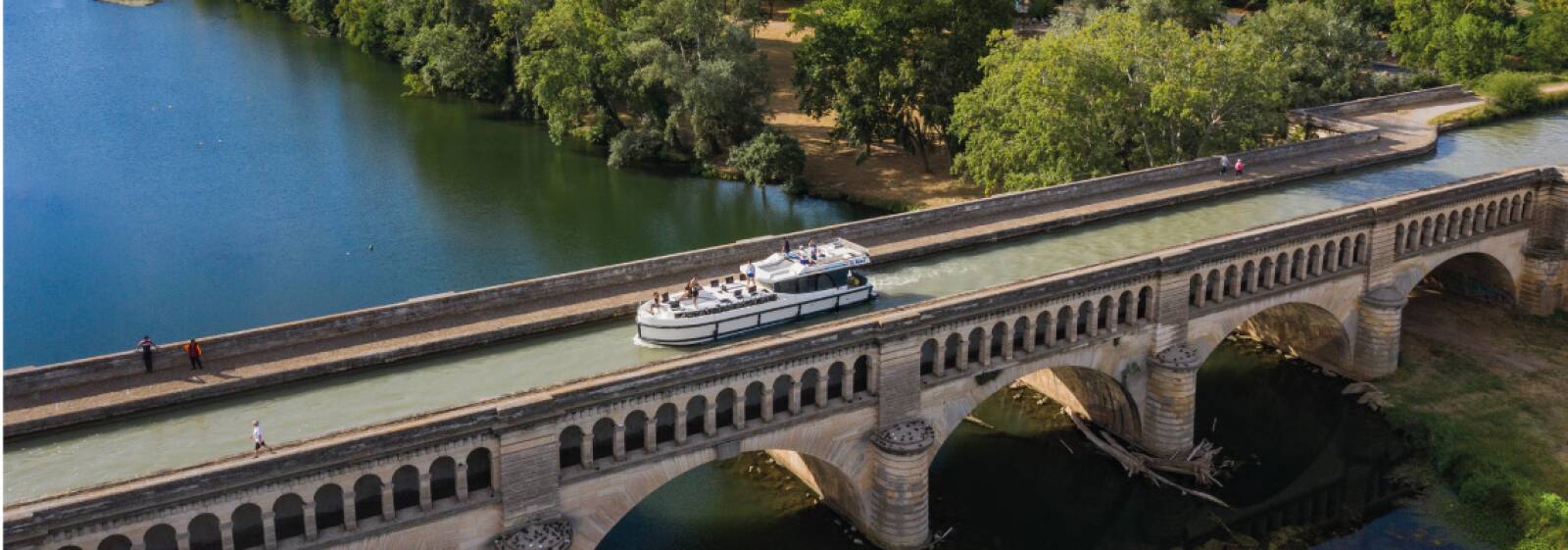
River Cruise Le Somail / Port Lauragais - Carcassonne / Bellegarde
Crisboat - Expert in river boat rental for over 20 years
Le Somail - Port Lauragais - Carcassonne - Bellegarde - 401 Km - 131 Locks - 80 h of navigation - 3 Weeks
From Le Somail to Argens, 15 km, 1 Lock(s), 2.2 h of navigation
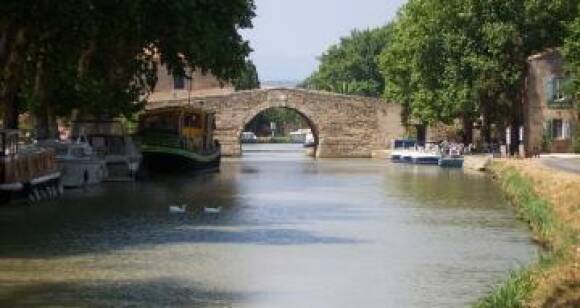
 Monument
Monument
Le Somail
In addition to its Hat-making Museum and its old bridge, Le Somail has 4 structures listed as historical monuments: the former icehouse, the chapel, the old guard building and the former inn.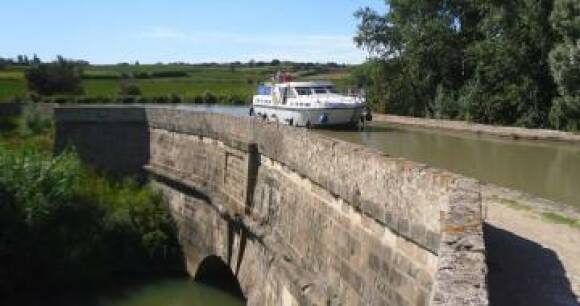
 River constructions
River constructions
the Canal Bridge of the Repudre
Throughout the length of the Canal du Midi there are 49 aqueducts, most of them built by Vauban; only the Répudre Aqueduct was completed during the building of the canal, in 1676. Monument
Monument
La bibliothèque
The bookstore "Le trouve tout du livre" contains over 50,000 books and manuscripts.From Argens to Puichéric, 16 km, 7 Lock(s), 3.5 h of navigation
 Monument
Monument
Puichéric
A village with a medieval character located along the Canal du Midi, also known as “the Venice of Minervois” due to the three rivers that flow through it. It has a timeless charm that should not be missed. Monument
Monument
Homps
A small village known for its harbor and pleasant recreational lake, Lac de Jouarres. Don’t forget to stop by the Maison des Vins du Minervois at the port, which offers a selection of the best wines. The famous blue footbridge leading to Lac de Jouarres is worth a visit. Vineyard
Vineyard
The Wine House
At the port of Homps, you will find the Minervois Wine House, which offers a selection of the finest wines and showcases the expertise of winemakers from the Aude region. Swimming
Swimming
the pond of Jouarre/Homps
A 100ha lake, situated a few meters from the Canal du Midi, where it is possible to bathe. Sports and leisure activities
Sports and leisure activities
the pond of Jouarre/Homps
A 100ha lake, situated a few meters from the Canal du Midi, where it is possible to go sailing. River constructions
River constructions
Le Pont-Canal du Rivassel
The Rivassel Aqueduct is one of the many bridges of this kind along the Canal du Midi. It crosses the small "Ruisseau de Naval" stream.From Puichéric to Trèbes, 17 km, 11 Lock(s), 4.5 h of navigation
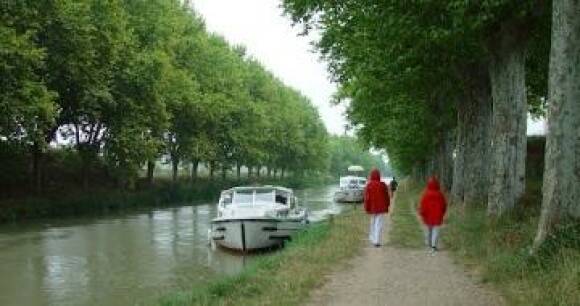
 Monument
Monument
Marseillette
Wedged between the Minervois and Corbières vineyards, today this town is known for producing the most rice in the region; the rice fields can be seen from the lagoon.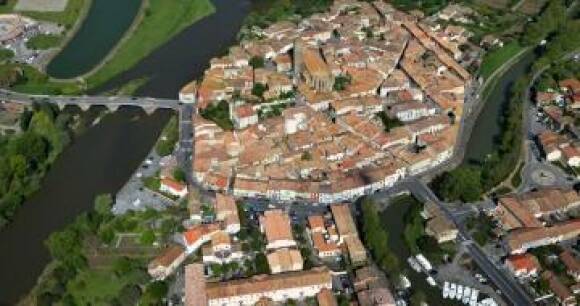
 Monument
Monument
Trèbes
The old village, with its narrow streets, was built around the Church of Saint-Etienne. The latter houses the "Treasures of Trèbes": 320 oak corbels which support the structural beams, each featuring a painted figure: men, women, animals… Monument
Monument
Puichéric
A village with a medieval character located along the Canal du Midi, also known as “the Venice of Minervois” due to the three rivers that flow through it. It has a timeless charm that should not be missed. Monument
Monument
Saint Stephen’s Church
Saint Stephen’s Church, in the Southern Gothic style, houses the "Treasure of Trèbes": 320 oak corbels supporting the beams of a timber frame classified as a Historic Monument. Monument
Monument
La Tour de l’Horloge
The Clock Tower served as a relay station for the world’s first telecommunications network. Nature
Nature
The rice field
The Saint-Gabriel estate, which has focused primarily on winegrowing since 1925, stands out for its 70 hectares of rice-growing. The estate recently launched Orizginale, a gluten-free, organic craft beer made from rice grown on the estate. Vineyard
Vineyard
the Minervois
 Vineyard
Vineyard
the Corbières
 River constructions
River constructions
The Moulins Locks
The Trèbes locks form a lock staircase consisting of three basins. Built around 1674, it is located downstream of the port of Trèbes, at the town’s exit toward the village of Marseillette. Taking advantage of the steep gradient of the lock staircase, a thriving milling industry developed on the left bank of the lock.From Trèbes to Carcassonne, 14 km, 7 Lock(s), 3.3 h of navigation

 Monument
Monument
Trèbes
The old village, with its narrow streets, was built around the Church of Saint-Etienne. The latter houses the "Treasures of Trèbes": 320 oak corbels which support the structural beams, each featuring a painted figure: men, women, animals…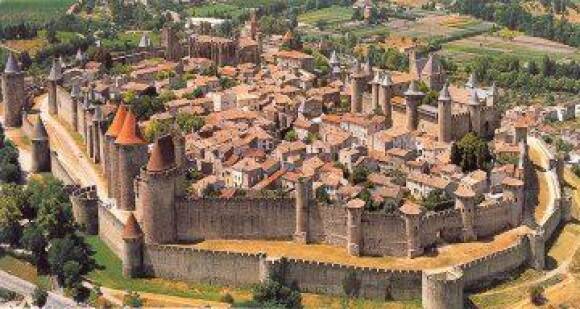
 Monument
Monument
Carcassonne
The medieval city of Carcassonne has had two designations as a UNESCO World Heritage Site since 1997. Dating back to the Roman Empire, this fortified city later became a garrison town. Monument
Monument
La Bastide Saint-Louis
La Bastide Saint-Louis is at the heart of the city. It embodies the warm, friendly spirit of Carcassonne and is home to many shops, restaurants, squares, and parks. Monument
Monument
The Medieval City
Just a 10-minute walk from the Bastide is the famous Medieval City, open free of charge 24/7. Guided tours, both day and night, are offered to uncover the secrets and history of the City. Monument
Monument
The Comtal Castle
In the heart of the medieval city, you will find the imposing Comtal Castle. Admission is paid, but free for visitors under 26 years old. Monument
Monument
Saint Stephen’s Church
Saint Stephen’s Church, in the Southern Gothic style, houses the "Treasure of Trèbes": 320 oak corbels supporting the beams of a timber frame classified as a Historic Monument. Vineyard
Vineyard
the Côtes de Malepère
 Gastronomy
Gastronomy
the Artichauts à la Carcassonnaise
 Gastronomy
Gastronomy
Le Petit Carcassonnais
This small oval cake, with a texture similar to a sponge cake or a madeleine, reveals subtle flavors of candied orange peel when you taste it. This specialty was created in 1928 by Mr. Gau and was later acquired by the Fuster family, who are currently the sole producers of this delicacy. Gastronomy
Gastronomy
Le Poumpet
A cake originating from Soual and Sémalens, brought to Carcassonne in the 8th century, made with lemon and bergamot. Triangular in shape, it was traditionally made with lard. Today, it is usually made with butter. It has gained great popularity thanks to its blend of lemon, bergamot, and honey added after baking. It is perfect for lemon lovers. Gastronomy
Gastronomy
Les Écus de la Cité
By far, this is the sweetest memory you’ll take away from Carcassonne. Small and round in shape, these little coins featuring the medieval city come in dark chocolate or milk chocolate. 7 Avenue Arthur Mullot, 11000 Carcassonne River constructions
River constructions
Pont Marengo
The Marengo Bridge, downstream from Lock 40, is known to be the lowest on the canal. Be sure to warn all your crew members before passing under it. River constructions
River constructions
The Moulins Locks
The Trèbes locks form a lock staircase consisting of three basins. Built around 1674, it is located downstream of the port of Trèbes, at the town’s exit toward the village of Marseillette. Taking advantage of the steep gradient of the lock staircase, a thriving milling industry developed on the left bank of the lock. River constructions
River constructions
Les écluses et le Pont-Canal du Fresquel
The Fresquel site consists of the Fresquel aqueduct, a lock from the era of Pierre-Paul Riquet, and a double lock built at the same time as the aqueduct. The 135-meter reach between the two locks is the shortest on the Canal du Midi. River constructions
River constructions
The Orbiel Aqueduct
This beautiful structure with three arches, where the Canal crosses the Orbiel Valley, was built based on Vauban’s plans in 1688. It is one of the first large canal bridges constructed in France. The original method for crossing the Orbiel was quite different. A causeway had been built to raise the waters of the Orbiel to the level of the Canal. Boats would pass behind this dam to reach the other shore.From Carcassonne to Bram, 23 km, 6 Lock(s), 4.3 h of navigation

 Monument
Monument
Carcassonne
The medieval city of Carcassonne has had two designations as a UNESCO World Heritage Site since 1997. Dating back to the Roman Empire, this fortified city later became a garrison town.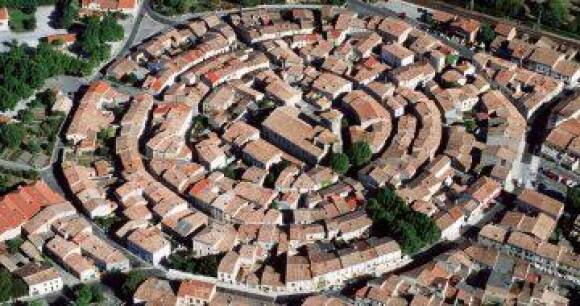
 Monument
Monument
Bram
Bram, the circular town with its 13th century church. At the House of Archaeology you can discover the ancient past of this city. Monument
Monument
Presbytère de Villesèquelande
An old 11th-century building that was part of the village’s former castle, which was destroyed. It was restored in 1991 and has since belonged to the municipality, but traces of Raymond de Villesèquelande’s presence can still be found. Monument
Monument
La Bastide Saint-Louis
La Bastide Saint-Louis is at the heart of the city. It embodies the warm, friendly spirit of Carcassonne and is home to many shops, restaurants, squares, and parks. Monument
Monument
The Medieval City
Just a 10-minute walk from the Bastide is the famous Medieval City, open free of charge 24/7. Guided tours, both day and night, are offered to uncover the secrets and history of the City. Monument
Monument
Villesèquelande
A small, authentic village with just a few inhabitants. It is crossed by an ancient Roman road. It is home to one of the last elm trees in Western Europe, and since 2021, Villesèquelande has even become the world’s first Tree Village. Monument
Monument
The Comtal Castle
In the heart of the medieval city, you will find the imposing Comtal Castle. Admission is paid, but free for visitors under 26 years old. Monument
Monument
The Church of Saint Julien and Saint Basilisse
A true jewel of the village, it is the starting point of the “circular village.” Hidden in the heart of the town, it is one of the rare churches still found in France with a single nave featuring three rib-vaulted bays and a 36-meter bell tower. Come and discover its Gothic architecture, which dominates the village! Nature
Nature
Parc des Essars
The Parc des Essars is an ideal place for a stroll. At the heart of the park is an exhibition centre dedicated entirely to the visual arts and culture. Vineyard
Vineyard
the Côtes de Malepère
 Gastronomy
Gastronomy
the Artichauts à la Carcassonnaise
 Gastronomy
Gastronomy
Le Petit Carcassonnais
This small oval cake, with a texture similar to a sponge cake or a madeleine, reveals subtle flavors of candied orange peel when you taste it. This specialty was created in 1928 by Mr. Gau and was later acquired by the Fuster family, who are currently the sole producers of this delicacy. Gastronomy
Gastronomy
Le Poumpet
A cake originating from Soual and Sémalens, brought to Carcassonne in the 8th century, made with lemon and bergamot. Triangular in shape, it was traditionally made with lard. Today, it is usually made with butter. It has gained great popularity thanks to its blend of lemon, bergamot, and honey added after baking. It is perfect for lemon lovers. Gastronomy
Gastronomy
Les Écus de la Cité
By far, this is the sweetest memory you’ll take away from Carcassonne. Small and round in shape, these little coins featuring the medieval city come in dark chocolate or milk chocolate. 7 Avenue Arthur Mullot, 11000 Carcassonne Swimming
Swimming
Le Lac de Buzerens
Lake Buzerens offers a variety of activities: fishing, supervised swimming, wakeboarding, paddleboarding, and water skiing. River constructions
River constructions
Aqueduc de Rebenty
Cross over the Rebenty stream, originally built in 1687, to prevent the stream's waters from mixing with those of the canal. Composed of four arches, this aqueduct was accompanied by a gatehouse that has now been completely destroyed.From Bram to Castelnaudary, 16 km, 17 Lock(s), 5.5 h of navigation
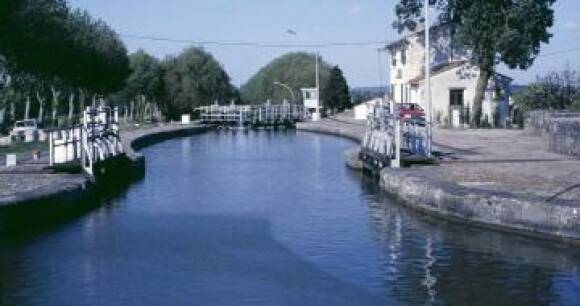
 Monument
Monument
Villepinte
The 12th century Romanesque chapel of Notre-Dame de la Romenguière.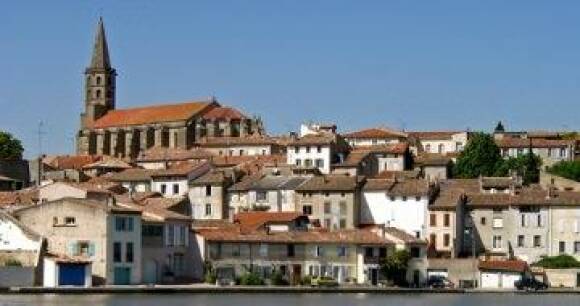
 Monument
Monument
Castelnaudary
This town, widely known for its Cassoulet, also features a number of interesting historical monuments, such as the Collegiate Church of Saint-Michel, the Moulin (windmill) de Curagel, or even the 13th century Chapel of Notre Dame de Pitié.
 Monument
Monument
Bram
Bram, the circular town with its 13th century church. At the House of Archaeology you can discover the ancient past of this city.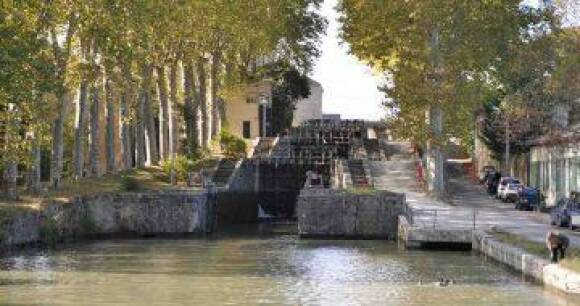
 River constructions
River constructions
the locks scale of Saint-Roch
This ladder of locks, near to Castelnaudary, was constructed in 1678. It was electrified by the Germans during the Second World War. Monument
Monument
Eglise de Villepinte
The church was built around an old Romanesque chapel, of which only remnants now remain within the new structure. The original construction, along with subsequent renovation work, was carried out in stages, with the most recent significant modification dating back to 1991. Monument
Monument
The Collegiate Church of Saint Michael
This magnificent 13th-century church overlooks the town of Castelnaudary with its beautiful bell tower. Don’t hesitate to step inside to discover its baroque high altar and grand organ. Monument
Monument
Lavoir et Epanchoir
Ancient washhouses are located opposite a magnificent eight-arched spillway that transfers excess water to the Fresquel River. These structures reflect the way of life of the time and are still in very good condition, allowing for clear observation from your houseboat. Monument
Monument
The Church of Saint Julien and Saint Basilisse
A true jewel of the village, it is the starting point of the “circular village.” Hidden in the heart of the town, it is one of the rare churches still found in France with a single nave featuring three rib-vaulted bays and a 36-meter bell tower. Come and discover its Gothic architecture, which dominates the village! Nature
Nature
Cybelle Island
Let yourself be tempted by this island, moor up discreetly and watch the animals, ducks and migratory birds, in their natural environment. Nature
Nature
Parc des Essars
The Parc des Essars is an ideal place for a stroll. At the heart of the park is an exhibition centre dedicated entirely to the visual arts and culture. Gastronomy
Gastronomy
the Cassoulet of Castelnaudary
 Swimming
Swimming
Le Lac de Buzerens
Lake Buzerens offers a variety of activities: fishing, supervised swimming, wakeboarding, paddleboarding, and water skiing. River constructions
River constructions
Le Pont-Canal du Tréboul
The Tréboul Aqueduct is one of the many structures along the Canal du Midi. Located in the commune of Lasbordes, it crosses the Tréboul stream, which later flows into the Fresquel. This aqueduct is situated just 100 meters from the Tréboul lock. River constructions
River constructions
Echelle du Vivier
The Vivier Lock is a staircase of three locks. Built around 1674, it is located 68.7 km from Toulouse, at an altitude of 154 meters. The neighboring locks are the Guillermin Lock to the east and the Gay Lock to the west. River constructions
River constructions
Ecluses de Saint-Roch
This series of four locks, built in 1678 at the exit of Castelnaudary heading toward Carcassonne, allows barges to overcome a 10-meter elevation difference. Nearby, two mills and a flour mill were constructed in 1680, adding a historical and industrial dimension to this remarkable site. River constructions
River constructions
The Cugarel Windmill
This former flour windmill from the 17th century operated until 1921. It overlooks the entire Lauragais plain, offering a beautiful panoramic view. River constructions
River constructions
Le Pont-Canal de Mezuran
One of the many aqueducts of the Canal du Midi, this one allows the canal to cross over a stream, while also offering an elevated view of the landscape and nature.From Castelnaudary to Port Lauragais, 15 km, 9 Lock(s), 3.8 h of navigation

 Monument
Monument
Castelnaudary
This town, widely known for its Cassoulet, also features a number of interesting historical monuments, such as the Collegiate Church of Saint-Michel, the Moulin (windmill) de Curagel, or even the 13th century Chapel of Notre Dame de Pitié. Monument
Monument
The Collegiate Church of Saint Michael
This magnificent 13th-century church overlooks the town of Castelnaudary with its beautiful bell tower. Don’t hesitate to step inside to discover its baroque high altar and grand organ. Nature
Nature
Cybelle Island
Let yourself be tempted by this island, moor up discreetly and watch the animals, ducks and migratory birds, in their natural environment. Gastronomy
Gastronomy
the Cassoulet of Castelnaudary
 River constructions
River constructions
Ecluses de Saint-Roch
This series of four locks, built in 1678 at the exit of Castelnaudary heading toward Carcassonne, allows barges to overcome a 10-meter elevation difference. Nearby, two mills and a flour mill were constructed in 1680, adding a historical and industrial dimension to this remarkable site. River constructions
River constructions
The Cugarel Windmill
This former flour windmill from the 17th century operated until 1921. It overlooks the entire Lauragais plain, offering a beautiful panoramic view.From Port Lauragais to Castelnaudary, 15 km, 9 Lock(s), 3.8 h of navigation

 Monument
Monument
Castelnaudary
This town, widely known for its Cassoulet, also features a number of interesting historical monuments, such as the Collegiate Church of Saint-Michel, the Moulin (windmill) de Curagel, or even the 13th century Chapel of Notre Dame de Pitié. Monument
Monument
The Collegiate Church of Saint Michael
This magnificent 13th-century church overlooks the town of Castelnaudary with its beautiful bell tower. Don’t hesitate to step inside to discover its baroque high altar and grand organ. Nature
Nature
Cybelle Island
Let yourself be tempted by this island, moor up discreetly and watch the animals, ducks and migratory birds, in their natural environment. Gastronomy
Gastronomy
the Cassoulet of Castelnaudary
 River constructions
River constructions
Ecluses de Saint-Roch
This series of four locks, built in 1678 at the exit of Castelnaudary heading toward Carcassonne, allows barges to overcome a 10-meter elevation difference. Nearby, two mills and a flour mill were constructed in 1680, adding a historical and industrial dimension to this remarkable site. River constructions
River constructions
The Cugarel Windmill
This former flour windmill from the 17th century operated until 1921. It overlooks the entire Lauragais plain, offering a beautiful panoramic view.From Castelnaudary to Villepinte, 12 km, 14 Lock(s), 4.4 h of navigation

 Monument
Monument
Villepinte
The 12th century Romanesque chapel of Notre-Dame de la Romenguière.
 Monument
Monument
Castelnaudary
This town, widely known for its Cassoulet, also features a number of interesting historical monuments, such as the Collegiate Church of Saint-Michel, the Moulin (windmill) de Curagel, or even the 13th century Chapel of Notre Dame de Pitié.
 River constructions
River constructions
the locks scale of Saint-Roch
This ladder of locks, near to Castelnaudary, was constructed in 1678. It was electrified by the Germans during the Second World War. Monument
Monument
Eglise de Villepinte
The church was built around an old Romanesque chapel, of which only remnants now remain within the new structure. The original construction, along with subsequent renovation work, was carried out in stages, with the most recent significant modification dating back to 1991. Monument
Monument
The Collegiate Church of Saint Michael
This magnificent 13th-century church overlooks the town of Castelnaudary with its beautiful bell tower. Don’t hesitate to step inside to discover its baroque high altar and grand organ. Monument
Monument
Lavoir et Epanchoir
Ancient washhouses are located opposite a magnificent eight-arched spillway that transfers excess water to the Fresquel River. These structures reflect the way of life of the time and are still in very good condition, allowing for clear observation from your houseboat. Nature
Nature
Cybelle Island
Let yourself be tempted by this island, moor up discreetly and watch the animals, ducks and migratory birds, in their natural environment. Gastronomy
Gastronomy
the Cassoulet of Castelnaudary
 River constructions
River constructions
Le Pont-Canal du Tréboul
The Tréboul Aqueduct is one of the many structures along the Canal du Midi. Located in the commune of Lasbordes, it crosses the Tréboul stream, which later flows into the Fresquel. This aqueduct is situated just 100 meters from the Tréboul lock. River constructions
River constructions
Echelle du Vivier
The Vivier Lock is a staircase of three locks. Built around 1674, it is located 68.7 km from Toulouse, at an altitude of 154 meters. The neighboring locks are the Guillermin Lock to the east and the Gay Lock to the west. River constructions
River constructions
Ecluses de Saint-Roch
This series of four locks, built in 1678 at the exit of Castelnaudary heading toward Carcassonne, allows barges to overcome a 10-meter elevation difference. Nearby, two mills and a flour mill were constructed in 1680, adding a historical and industrial dimension to this remarkable site. River constructions
River constructions
The Cugarel Windmill
This former flour windmill from the 17th century operated until 1921. It overlooks the entire Lauragais plain, offering a beautiful panoramic view. River constructions
River constructions
Le Pont-Canal de Mezuran
One of the many aqueducts of the Canal du Midi, this one allows the canal to cross over a stream, while also offering an elevated view of the landscape and nature.From Villepinte to Villesèquelande, 14 km, 4 Lock(s), 2.7 h of navigation

 Monument
Monument
Villepinte
The 12th century Romanesque chapel of Notre-Dame de la Romenguière.
 Monument
Monument
Bram
Bram, the circular town with its 13th century church. At the House of Archaeology you can discover the ancient past of this city. Monument
Monument
Presbytère de Villesèquelande
An old 11th-century building that was part of the village’s former castle, which was destroyed. It was restored in 1991 and has since belonged to the municipality, but traces of Raymond de Villesèquelande’s presence can still be found. Monument
Monument
Eglise de Villepinte
The church was built around an old Romanesque chapel, of which only remnants now remain within the new structure. The original construction, along with subsequent renovation work, was carried out in stages, with the most recent significant modification dating back to 1991. Monument
Monument
Villesèquelande
A small, authentic village with just a few inhabitants. It is crossed by an ancient Roman road. It is home to one of the last elm trees in Western Europe, and since 2021, Villesèquelande has even become the world’s first Tree Village. Monument
Monument
Lavoir et Epanchoir
Ancient washhouses are located opposite a magnificent eight-arched spillway that transfers excess water to the Fresquel River. These structures reflect the way of life of the time and are still in very good condition, allowing for clear observation from your houseboat. Monument
Monument
The Church of Saint Julien and Saint Basilisse
A true jewel of the village, it is the starting point of the “circular village.” Hidden in the heart of the town, it is one of the rare churches still found in France with a single nave featuring three rib-vaulted bays and a 36-meter bell tower. Come and discover its Gothic architecture, which dominates the village! Nature
Nature
Parc des Essars
The Parc des Essars is an ideal place for a stroll. At the heart of the park is an exhibition centre dedicated entirely to the visual arts and culture. Swimming
Swimming
Le Lac de Buzerens
Lake Buzerens offers a variety of activities: fishing, supervised swimming, wakeboarding, paddleboarding, and water skiing. River constructions
River constructions
Aqueduc de Rebenty
Cross over the Rebenty stream, originally built in 1687, to prevent the stream's waters from mixing with those of the canal. Composed of four arches, this aqueduct was accompanied by a gatehouse that has now been completely destroyed. River constructions
River constructions
Echelle du Vivier
The Vivier Lock is a staircase of three locks. Built around 1674, it is located 68.7 km from Toulouse, at an altitude of 154 meters. The neighboring locks are the Guillermin Lock to the east and the Gay Lock to the west. River constructions
River constructions
Le Pont-Canal de Mezuran
One of the many aqueducts of the Canal du Midi, this one allows the canal to cross over a stream, while also offering an elevated view of the landscape and nature.From Villesèquelande to Carcassonne, 13 km, 5 Lock(s), 2.7 h of navigation

 Monument
Monument
Carcassonne
The medieval city of Carcassonne has had two designations as a UNESCO World Heritage Site since 1997. Dating back to the Roman Empire, this fortified city later became a garrison town. Monument
Monument
Presbytère de Villesèquelande
An old 11th-century building that was part of the village’s former castle, which was destroyed. It was restored in 1991 and has since belonged to the municipality, but traces of Raymond de Villesèquelande’s presence can still be found. Monument
Monument
La Bastide Saint-Louis
La Bastide Saint-Louis is at the heart of the city. It embodies the warm, friendly spirit of Carcassonne and is home to many shops, restaurants, squares, and parks. Monument
Monument
The Medieval City
Just a 10-minute walk from the Bastide is the famous Medieval City, open free of charge 24/7. Guided tours, both day and night, are offered to uncover the secrets and history of the City. Monument
Monument
Villesèquelande
A small, authentic village with just a few inhabitants. It is crossed by an ancient Roman road. It is home to one of the last elm trees in Western Europe, and since 2021, Villesèquelande has even become the world’s first Tree Village. Monument
Monument
The Comtal Castle
In the heart of the medieval city, you will find the imposing Comtal Castle. Admission is paid, but free for visitors under 26 years old. Vineyard
Vineyard
the Côtes de Malepère
 Gastronomy
Gastronomy
the Artichauts à la Carcassonnaise
 Gastronomy
Gastronomy
Le Petit Carcassonnais
This small oval cake, with a texture similar to a sponge cake or a madeleine, reveals subtle flavors of candied orange peel when you taste it. This specialty was created in 1928 by Mr. Gau and was later acquired by the Fuster family, who are currently the sole producers of this delicacy. Gastronomy
Gastronomy
Le Poumpet
A cake originating from Soual and Sémalens, brought to Carcassonne in the 8th century, made with lemon and bergamot. Triangular in shape, it was traditionally made with lard. Today, it is usually made with butter. It has gained great popularity thanks to its blend of lemon, bergamot, and honey added after baking. It is perfect for lemon lovers. Gastronomy
Gastronomy
Les Écus de la Cité
By far, this is the sweetest memory you’ll take away from Carcassonne. Small and round in shape, these little coins featuring the medieval city come in dark chocolate or milk chocolate. 7 Avenue Arthur Mullot, 11000 CarcassonneFrom Carcassonne to Trèbes, 14 km, 7 Lock(s), 3.3 h of navigation

 Monument
Monument
Trèbes
The old village, with its narrow streets, was built around the Church of Saint-Etienne. The latter houses the "Treasures of Trèbes": 320 oak corbels which support the structural beams, each featuring a painted figure: men, women, animals…
 Monument
Monument
Carcassonne
The medieval city of Carcassonne has had two designations as a UNESCO World Heritage Site since 1997. Dating back to the Roman Empire, this fortified city later became a garrison town. Monument
Monument
La Bastide Saint-Louis
La Bastide Saint-Louis is at the heart of the city. It embodies the warm, friendly spirit of Carcassonne and is home to many shops, restaurants, squares, and parks. Monument
Monument
The Medieval City
Just a 10-minute walk from the Bastide is the famous Medieval City, open free of charge 24/7. Guided tours, both day and night, are offered to uncover the secrets and history of the City. Monument
Monument
The Comtal Castle
In the heart of the medieval city, you will find the imposing Comtal Castle. Admission is paid, but free for visitors under 26 years old. Monument
Monument
Saint Stephen’s Church
Saint Stephen’s Church, in the Southern Gothic style, houses the "Treasure of Trèbes": 320 oak corbels supporting the beams of a timber frame classified as a Historic Monument. Vineyard
Vineyard
the Côtes de Malepère
 Gastronomy
Gastronomy
the Artichauts à la Carcassonnaise
 Gastronomy
Gastronomy
Le Petit Carcassonnais
This small oval cake, with a texture similar to a sponge cake or a madeleine, reveals subtle flavors of candied orange peel when you taste it. This specialty was created in 1928 by Mr. Gau and was later acquired by the Fuster family, who are currently the sole producers of this delicacy. Gastronomy
Gastronomy
Le Poumpet
A cake originating from Soual and Sémalens, brought to Carcassonne in the 8th century, made with lemon and bergamot. Triangular in shape, it was traditionally made with lard. Today, it is usually made with butter. It has gained great popularity thanks to its blend of lemon, bergamot, and honey added after baking. It is perfect for lemon lovers. Gastronomy
Gastronomy
Les Écus de la Cité
By far, this is the sweetest memory you’ll take away from Carcassonne. Small and round in shape, these little coins featuring the medieval city come in dark chocolate or milk chocolate. 7 Avenue Arthur Mullot, 11000 Carcassonne River constructions
River constructions
Pont Marengo
The Marengo Bridge, downstream from Lock 40, is known to be the lowest on the canal. Be sure to warn all your crew members before passing under it. River constructions
River constructions
The Moulins Locks
The Trèbes locks form a lock staircase consisting of three basins. Built around 1674, it is located downstream of the port of Trèbes, at the town’s exit toward the village of Marseillette. Taking advantage of the steep gradient of the lock staircase, a thriving milling industry developed on the left bank of the lock. River constructions
River constructions
Les écluses et le Pont-Canal du Fresquel
The Fresquel site consists of the Fresquel aqueduct, a lock from the era of Pierre-Paul Riquet, and a double lock built at the same time as the aqueduct. The 135-meter reach between the two locks is the shortest on the Canal du Midi. River constructions
River constructions
The Orbiel Aqueduct
This beautiful structure with three arches, where the Canal crosses the Orbiel Valley, was built based on Vauban’s plans in 1688. It is one of the first large canal bridges constructed in France. The original method for crossing the Orbiel was quite different. A causeway had been built to raise the waters of the Orbiel to the level of the Canal. Boats would pass behind this dam to reach the other shore.From Trèbes to Puichéric, 17 km, 11 Lock(s), 4.5 h of navigation

 Monument
Monument
Marseillette
Wedged between the Minervois and Corbières vineyards, today this town is known for producing the most rice in the region; the rice fields can be seen from the lagoon.
 Monument
Monument
Trèbes
The old village, with its narrow streets, was built around the Church of Saint-Etienne. The latter houses the "Treasures of Trèbes": 320 oak corbels which support the structural beams, each featuring a painted figure: men, women, animals… Monument
Monument
Puichéric
A village with a medieval character located along the Canal du Midi, also known as “the Venice of Minervois” due to the three rivers that flow through it. It has a timeless charm that should not be missed. Monument
Monument
Saint Stephen’s Church
Saint Stephen’s Church, in the Southern Gothic style, houses the "Treasure of Trèbes": 320 oak corbels supporting the beams of a timber frame classified as a Historic Monument. Monument
Monument
La Tour de l’Horloge
The Clock Tower served as a relay station for the world’s first telecommunications network. Nature
Nature
The rice field
The Saint-Gabriel estate, which has focused primarily on winegrowing since 1925, stands out for its 70 hectares of rice-growing. The estate recently launched Orizginale, a gluten-free, organic craft beer made from rice grown on the estate. Vineyard
Vineyard
the Minervois
 Vineyard
Vineyard
the Corbières
 River constructions
River constructions
The Moulins Locks
The Trèbes locks form a lock staircase consisting of three basins. Built around 1674, it is located downstream of the port of Trèbes, at the town’s exit toward the village of Marseillette. Taking advantage of the steep gradient of the lock staircase, a thriving milling industry developed on the left bank of the lock.From Puichéric to Argens, 16 km, 7 Lock(s), 3.5 h of navigation
 Monument
Monument
Puichéric
A village with a medieval character located along the Canal du Midi, also known as “the Venice of Minervois” due to the three rivers that flow through it. It has a timeless charm that should not be missed. Monument
Monument
Homps
A small village known for its harbor and pleasant recreational lake, Lac de Jouarres. Don’t forget to stop by the Maison des Vins du Minervois at the port, which offers a selection of the best wines. The famous blue footbridge leading to Lac de Jouarres is worth a visit. Vineyard
Vineyard
The Wine House
At the port of Homps, you will find the Minervois Wine House, which offers a selection of the finest wines and showcases the expertise of winemakers from the Aude region. Swimming
Swimming
the pond of Jouarre/Homps
A 100ha lake, situated a few meters from the Canal du Midi, where it is possible to bathe. Sports and leisure activities
Sports and leisure activities
the pond of Jouarre/Homps
A 100ha lake, situated a few meters from the Canal du Midi, where it is possible to go sailing. River constructions
River constructions
Le Pont-Canal du Rivassel
The Rivassel Aqueduct is one of the many bridges of this kind along the Canal du Midi. It crosses the small "Ruisseau de Naval" stream.From Argens to Capestang, 38 km, 1 Lock(s), 5.3 h of navigation
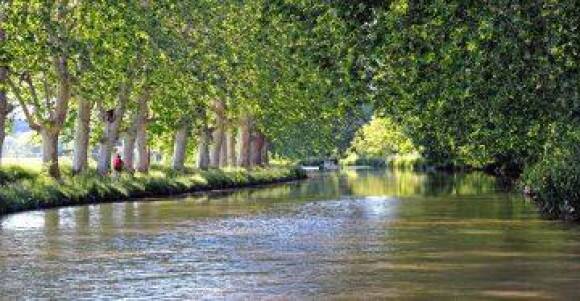
 Monument
Monument
Le Canal du Midi
The Canal du Midi is a designated UNESCO World Heritage Site.
 Monument
Monument
Le Somail
In addition to its Hat-making Museum and its old bridge, Le Somail has 4 structures listed as historical monuments: the former icehouse, the chapel, the old guard building and the former inn.
 River constructions
River constructions
the Canal Bridge of the Repudre
Throughout the length of the Canal du Midi there are 49 aqueducts, most of them built by Vauban; only the Répudre Aqueduct was completed during the building of the canal, in 1676. Monument
Monument
The Collegiate Church of Saint Stephen
In perfect Gothic style, the Collegiate Church of Saint Stephen in Capestang was built in the 13th century on the site of an earlier Romanesque church, likely by the same team that constructed the Saint-Just and Saint-Pasteur Cathedral in Narbonne. The building was listed as a historic monument in 1906. Monument
Monument
La bibliothèque
The bookstore "Le trouve tout du livre" contains over 50,000 books and manuscripts. Monument
Monument
Capestang
Charming village nestled in the bends of the Canal du Midi, Capestang experienced prosperous times in the Middle Ages. Today, its heritage bears witness to that history. Monument
Monument
The Archbishops' Castle
Come and discover the summer residence of the Archbishops of Narbonne in Capestang. This castle houses a painted ceiling dating back to the 15th century. You can admire numerous scenes from the era (animals, romantic and religious scenes) on the beams. At the end of the Middle Ages, the castle was a splendid residence that some documents even describe as a palace. The Interpretation Center will provide you with insights into the ceiling and the history of the castle. Vineyard
Vineyard
the Saint Chinian
 River constructions
River constructions
Le Pont-Canal de Cesse
The Cesse Aqueduct, built from 1689 to 1690 by Vauban and engineer Jean Goudet, is 64 meters long and 14 meters high. It is located at the level of the main reach of the Canal du Midi, which is primarily fed by the Cesse River. River constructions
River constructions
Aqueduc de Quarante
This aqueduct was built by a certain Rusquier under the orders of Vauban. When it was completed in 1693, it had two arches, and a third was added in 1737.From Capestang to Béziers, 19 km, 7 Lock(s), 3.9 h of navigation
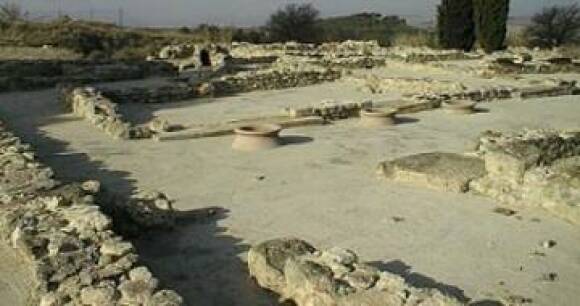
 Monument
Monument
The oppidum ofEnsérune
Located above the Malpas tunnel, the Oppidum d'Ensérune is an archaeological site where relics of the Greek, Celtic and Roman civilizations were discovered. There are still traces of the human occupation of this site from 800 B.C. through to the Christian era.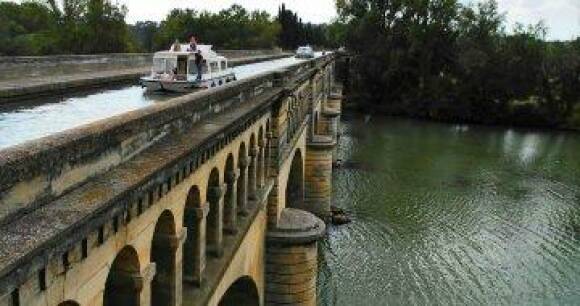
 River constructions
River constructions
the Canal Bridge of Beziers
Built in 1856, this aqueduct allows the Orb river to be crossed in a barge. 198m in length and 8m wide, it is considered the most beautiful stone canal bridge of the 19th century.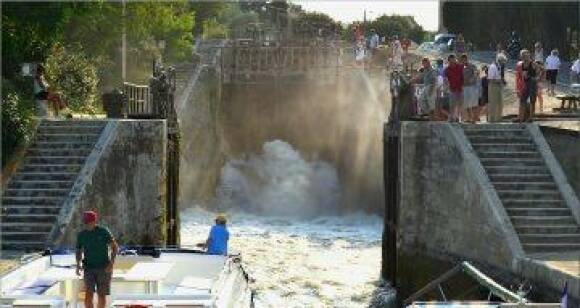
 River constructions
River constructions
the scale of Fonserannes
In order to descend from 20m and get back to the level of the Orb river, Paul Riquet, the designer of the Canal du Midi, constructed a ladder of 7 locks; one of the most impressive sections of the Canal du Midi.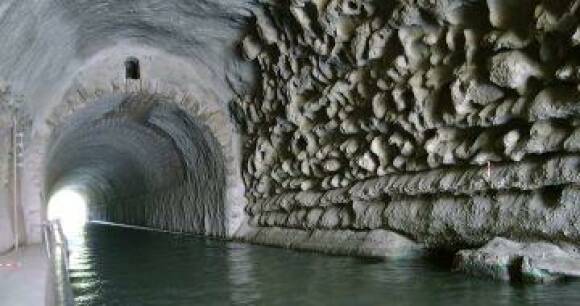
 River constructions
River constructions
the Tunnel of Malpas
In fact there are 3 tunnels placed on top of each other: an underground culvert for draining the water from the Montady Lagoon, the SNCF rail tunnel, and at the top the passage of the Canal du Midi. A unique piece of work navigated by barge without a permit. Monument
Monument
Colombiers Castle
The former cellar of Colombiers Castle offers tours and exhibitions dedicated to viticulture. Monument
Monument
Les Arènes de Béziers
The Béziers Arena, built in 1897, has long been a major center for bullfighting, earning Béziers the nickname "The French Seville." Throughout the year, this arena serves as the main meeting place for various festivities and events, notably the famous Béziers feria. Monument
Monument
Saint-Nazaire Cathedral
Saint Nazaire Cathedral is a city landmark, visible for miles around. Its history is told through its architecture. During your visit, explore the bell tower to enjoy panoramic views of the Biterrois wine plains, discover the unfinished cloister leading to the Bishops’ Garden, and stroll around the cathedral’s forecourt while admiring the surrounding landscape. Monument
Monument
The Collegiate Church of Saint Stephen
In perfect Gothic style, the Collegiate Church of Saint Stephen in Capestang was built in the 13th century on the site of an earlier Romanesque church, likely by the same team that constructed the Saint-Just and Saint-Pasteur Cathedral in Narbonne. The building was listed as a historic monument in 1906. Monument
Monument
Colombiers
You'll be charmed by the appeal of its small river port, perfect for a stopover during your cruise on the Canal du Midi. Nearby, the Oppidum of Ensérune rises, known for its archaeological site and museum. Take advantage of this walk to admire the exceptional view of the drained Colombiers-Montady pond. Monument
Monument
Capestang
Charming village nestled in the bends of the Canal du Midi, Capestang experienced prosperous times in the Middle Ages. Today, its heritage bears witness to that history. Monument
Monument
The Archbishops' Castle
Come and discover the summer residence of the Archbishops of Narbonne in Capestang. This castle houses a painted ceiling dating back to the 15th century. You can admire numerous scenes from the era (animals, romantic and religious scenes) on the beams. At the end of the Middle Ages, the castle was a splendid residence that some documents even describe as a palace. The Interpretation Center will provide you with insights into the ceiling and the history of the castle. Gastronomy
Gastronomy
Les Coques de Béziers
The Saint-Aphrodise coques, also known as Béziers coques, are a culinary specialty of the city. They are traditionally enjoyed during the feast of Saint Aphrodise, the patron saint of Béziers. Made with poolish, a liquid starter essential for achieving a soft and fluffy crumb, these delicious brioches are distinguished by their elongated shape and captivating aroma. They are perfect for breakfast or a tasty snack. To taste the best in Béziers, we recommend the bakery "Le Cristal," which won the "Golden Coque" contest. 44 Allées Paul Riquet, 34500 Béziers – 06 68 98 36 61From Béziers to Agde, 27 km, 7 Lock(s), 5 h of navigation
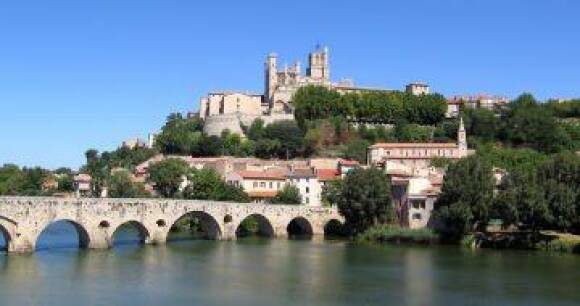
 Monument
Monument
Béziers
For a long time the French capital of table wine, this town features a historical center full of monuments: the Cathedral of Saint Nazaire, the Church of the Madeleine, and the Arena (seating 13,500), not forgetting the Feria (around the 15th August).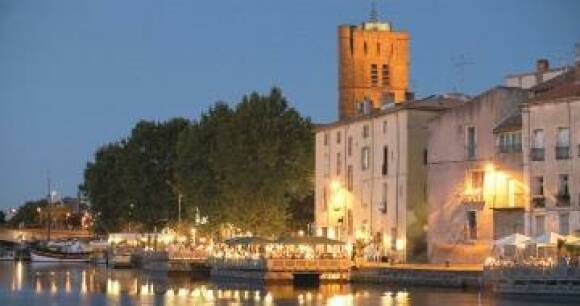
 Monument
Monument
Agde
Without doubt one of the oldest towns in Fance, Agde was built around 700 B.C. There a still a few remnants of this period, including a bronze bust, which is now on display at the musum in Cap d'Agde.
 River constructions
River constructions
the Canal Bridge of Beziers
Built in 1856, this aqueduct allows the Orb river to be crossed in a barge. 198m in length and 8m wide, it is considered the most beautiful stone canal bridge of the 19th century.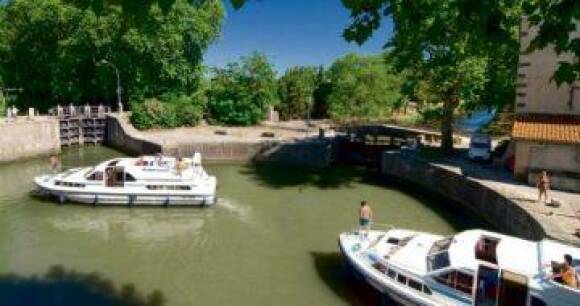
 River constructions
River constructions
the Round Lock of Agde
At the time of its construction at the crossing of the Hérault river and the Canal du Midi in 1680, this lock was a one of a kind piece of work.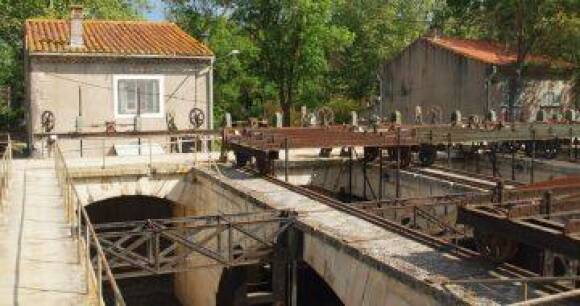
 River constructions
River constructions
the passage of Libron
For lack of relief, it was impossible to build an aqueduct at the crossing of the Libron river and the Canal du Midi. In 1857, it was decided to build a metal structure with sluice gates, allowing the waters of the Libron to pass in the case of flooding. This is a unique structure. Monument
Monument
The Greek city of Agde
Explore the city founded in the 6th century BC by the Phocaeans, featuring ancient ramparts, Saint Stephen’s Cathedral dating back to 872, and the churches of Saint Andrew and Saint Sever. Monument
Monument
The Fort of Brescou
Visit Fort Brescou, built on a volcanic islet, offering breathtaking views of the Mediterranean Sea. It was originally constructed in 1586 and later rebuilt by Vauban in the 1680s. Monument
Monument
Portiragnes
Portiragnes offers a perfect combination of fine sandy beaches, preserved nature, and historical heritage. Close to the Canal du Midi, you can enjoy the unspoiled coastline, the azure blue sea, and discover the RoqueHaute Regional Nature Reserve, a protected ecosystem home to a wide variety of plant and animal species. Monument
Monument
Les Arènes de Béziers
The Béziers Arena, built in 1897, has long been a major center for bullfighting, earning Béziers the nickname "The French Seville." Throughout the year, this arena serves as the main meeting place for various festivities and events, notably the famous Béziers feria. Monument
Monument
Saint-Nazaire Cathedral
Saint Nazaire Cathedral is a city landmark, visible for miles around. Its history is told through its architecture. During your visit, explore the bell tower to enjoy panoramic views of the Biterrois wine plains, discover the unfinished cloister leading to the Bishops’ Garden, and stroll around the cathedral’s forecourt while admiring the surrounding landscape. Monument
Monument
Saint Stephen’s Cathedral
Visit Saint Stephen’s Cathedral in Agde, a Romanesque-style building made of basalt stone, featuring a bell tower/donjon reaching 35 meters high and housing architectural and artistic treasures. Nature
Nature
Volcanic cliffs
Explore the volcanic cliffs on a sensational walk along the coastal path offering spectacular views of the Grande Conque beach and the creeks formed by erosion. Nature
Nature
the Natural Reserve of Roque-Haute
At more than 150ha in size, this reserve features more than 400 varieties of vegetable and 360 species of animal. Gastronomy
Gastronomy
the Bourride à l'Agathoise
 Gastronomy
Gastronomy
the Soupe d'ail at the Biterroise
 Gastronomy
Gastronomy
Petits pâtés de Pézenas
The taste of this small spool-shaped pâté is surprising. It comes from the clever blend of sweet (lemon and brown sugar) and savory (lamb) flavors. These flavors combine wonderfully and have made this specialty a success since the 18th century! Enjoy it slightly warmed, at the start of your meal, accompanied by a good glass of muscat! Gastronomy
Gastronomy
Les Coques de Béziers
The Saint-Aphrodise coques, also known as Béziers coques, are a culinary specialty of the city. They are traditionally enjoyed during the feast of Saint Aphrodise, the patron saint of Béziers. Made with poolish, a liquid starter essential for achieving a soft and fluffy crumb, these delicious brioches are distinguished by their elongated shape and captivating aroma. They are perfect for breakfast or a tasty snack. To taste the best in Béziers, we recommend the bakery "Le Cristal," which won the "Golden Coque" contest. 44 Allées Paul Riquet, 34500 Béziers – 06 68 98 36 61 Swimming
Swimming
The Cliffs Beach
This beach captivates with its black volcanic rocks, fine pink sand, and millions of pebbles. Accessible by stairs near a public parking lot, it offers a breathtaking view of the Cap d’Agde coastline. Swimming
Swimming
The Mole Beach
It features rides for children and pétanque courts. Additionally, it is located close to restaurants, shops, and bars. Accessible through pedestrian alleys, it offers the opportunity to swim at any time, with a lifeguard station on site. Swimming
Swimming
Portiragnes-Plages
Portiragnes-Plage offers a beautiful fine sandy beach, ideal for relaxing in the sun for a few hours. It is recommended to bring your own supplies, as there are no shops or stores nearby. Swimming
Swimming
The Grande Conque Beach
It is distinguished by the presence of the legendary "Two Brothers" rocks surrounded by black sand. Accessible via a small staircase between the aquarium and the cliffs, this peaceful cove carved into volcanic rock has a permanently staffed lifeguard station. Sports and leisure activities
Sports and leisure activities
Luna Park sur l’île des loisirs
Have fun with around thirty attractions in the heart of the marina. Sports and leisure activities
Sports and leisure activities
Azimut Aventure
This park offers tree-climbing courses of various levels and lengths, as well as zip line descents, all set in a beautiful park filled with century-old pines and plane trees, located 2.7 km from the Canal.From Agde to Frontignan, 24 km, 1 Lock(s), 3.4 h of navigation
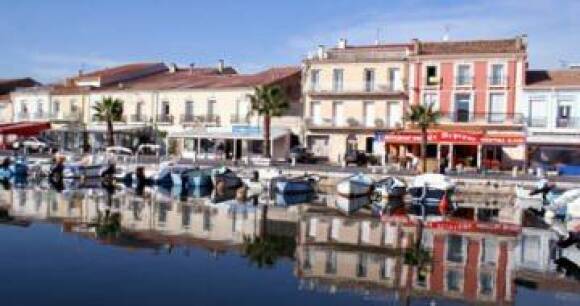
 Monument
Monument
Mèze
There are a few places of interest to discover in this old town dating from 600 B.C., with its fishing port at the edge of the Thau Lagoon: the Penitents' Chapel, the Church of Saint-Hilaire and the market buildings.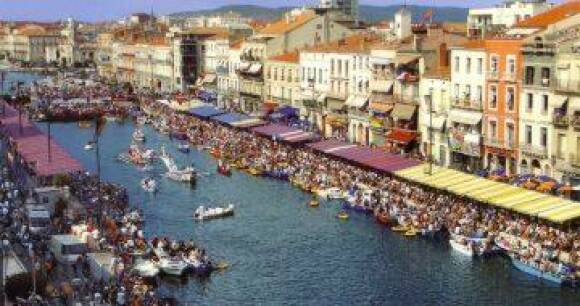
 Monument
Monument
Sète
The birthplace of George Brassens, a fact celebrated by the museum dedicated to him, is located right between the Thau lagoon and the Mediterranean. Nautical jousting tournaments take place here from May to September. Monument
Monument
Etang de Thau
A true inland sea between Sète and Marseillan, you will navigate on the largest body of water in Occitanie. You will enjoy pristine nature, a rich gastronomy featuring oysters and delicious wines, as well as a myriad of water activities. Monument
Monument
La cathédrale de Maguelone
Explore the Maguelone Cathedral, located on an island between Sète and Palavas-les-Flots. Enjoy the trails, vineyards, and surrounding nature. Monument
Monument
Marseillan
Marseillan is a charming town known for its economy based on fishing, agriculture, and tourism. The town attracts visitors with its beaches, marina, and vineyards, notably producing Muscat wine. Boasting a rich historical heritage, including the 13th-century Saint-Jean-Baptiste Church, Marseillan also offers cultural events throughout the year. Monument
Monument
Le Port de Marseillan
Visit the port of Marseillan-Ville, a former fishing and trading port, now transformed into a marina. Explore the docks, boats, and merchant houses. Monument
Monument
Le Phare Saint-Louis
Admire the panoramic view of the harbor, the old town, and the marina from the 33.5-meter-high lighthouse. Walk along the Saint-Louis pier promenade and discover the history of the ship L’Exodus. Nature
Nature
The Bagnas Nature Reserve
Explore the Bagnas Nature Reserve, located between Marseillan and Cap d’Agde, with its 561 hectares of hiking trails and 250 bird species. Nature
Nature
Le Mont Saint-Clair
Explore Mount Saint-Clair for a panoramic view of the Thau Archipelago from its 175-meter summit. You’ll walk through the White Stones forest. Nature
Nature
The Aresquiers Path
Follow one of the largest protected areas of the lagoon. After encountering the pink flamingos, the trail takes you through a pine forest filled with a thousand fragrances. Vineyard
Vineyard
the Picpoul de Pinet
 Vineyard
Vineyard
Les Caves Richemer
Explore the Richemer cellars to taste white and rosé wines. Vineyard
Vineyard
the Muscat de Frontignan
 Gastronomy
Gastronomy
the Bouillabaisse à la Sétoise
 Gastronomy
Gastronomy
the Oysters from Bouzigues
 Gastronomy
Gastronomy
Tabouriech Le St Barth
Enjoy oysters and mussels at Saint-Barth with a view of the lagoon and its oyster farms. Gastronomy
Gastronomy
La Tielle Setoise
Although the Tielle originates from Sète, it is often associated with the cuisine of Béziers. The Tielle Sétoise is a delicious small pie made with octopus and a slightly spicy tomato sauce. It’s hard to recommend the best one — even among locals from Sète, it’s a matter of debate... Swimming
Swimming
the Sete Beach
 Swimming
Swimming
the Mèze Beach
 Swimming
Swimming
the Marseillan Beach
 Swimming
Swimming
Robinson Beach
To the east of Marseillan, near Sète, this fine sandy beach is ideal for relaxing during your boat cruise without a license. It offers privacy thanks to a natural dune, is accessible to people with reduced mobility, and provides a family-friendly atmosphere with calm waters. Swimming
Swimming
the Bouzigues Beach
 Swimming
Swimming
The Honor Beach
Honor Beach in Marseillan, located along the Pisse Saumes canal, stands out as the town’s main beach for several reasons: its proximity to the port and recreational activities, its picturesque promenade, easy access to Avenue de la Méditerranée, and the installation of an audio beach system for people with disabilities. Sports and leisure activities
Sports and leisure activities
Circuit Patrimonial de Marseillan-Ville
Explore the history of Marseillan through 14 stops, including the port, Place Carnot, the Bayle Castle, and the Henri Maurin Theater. Sports and leisure activities
Sports and leisure activities
Balade équestre
Starting from the Mèze stables, play the role of a rider and explore the garrigue and the Thau Lagoon with family or friends. Pony or horseback rides will take you along the Via Domitia, through the Moure hills, around the Thau Lagoon, and along the Mediterranean coast.From Frontignan to La Grande Motte, 30 km, 0 Lock(s), 4 h of navigation
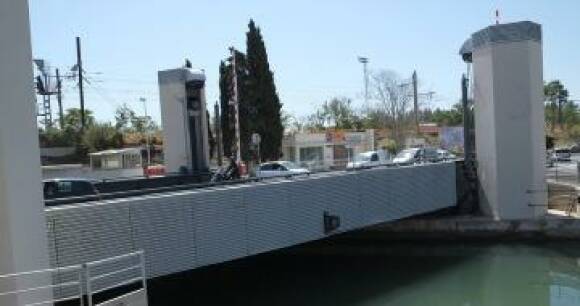
 River constructions
River constructions
the bridge of Frontignan
With an air draft of only 1.5m, it is necessary to wait for its deck to raise to pass on a barge. This occurs twice each day, at 8:30 and 16:00. Monument
Monument
Palavas-Les-Flots
Palavas-les-Flots, located 20 minutes from Montpellier at the mouth of the Lez River, is a former fishing village whose name derives from "palus-avis," meaning "the bird marsh." It offers visitors shops, restaurants, cafés, a casino, water sports, and more. Monument
Monument
Phare de la Méditerranée
Explore the Phare de la Méditerranée, a former water tower transformed into a restaurant with panoramic views. Relax in Parc Saint-Pierre, located at the foot of the lighthouse. Monument
Monument
La Grande-Motte
Designed in the 1960s by architect Jean Balladur, La Grande Motte is a seaside resort famous for its unique pyramid-shaped architecture. The town offers several kilometers of fine sandy beaches, a modern marina, and various water activities. A popular tourist destination, La Grande Motte attracts visitors with its summer atmosphere, festivals, and events throughout the year. Nature
Nature
Parc du Levant
Enjoy a relaxing time in this lovely park with its small lake, waterfall, and aviary. Discover the Redoute Ballestras, a former watchtower that now houses the Albert Dubout Museum. Vineyard
Vineyard
the Muscat de Lunel
 Swimming
Swimming
the Palavas les Flots Beach
 Swimming
Swimming
the Carnon Beach
 Sports and leisure activities
Sports and leisure activities
Ponant Aventure
For thrill-seekers, explore the 10 treetop adventure courses at Ponant Aventure, featuring over 140 challenges between sky and sea. This park offers an exceptional view from the wooden masts, which reach nearly 25 meters high. Sports and leisure activities
Sports and leisure activities
The Big Blue
Spend a relaxing day at Le Grand Bleu water park. Enjoy the indoor and outdoor pools, water slides, hot tubs, and green spaces perfect for picnicking. Sports and leisure activities
Sports and leisure activities
Le transcanal
Try the Transcanal, the shortest cable car in the world offering a panoramic view of the beach.From La Grande Motte to St Gilles, 34 km, 0 Lock(s), 4.5 h of navigation
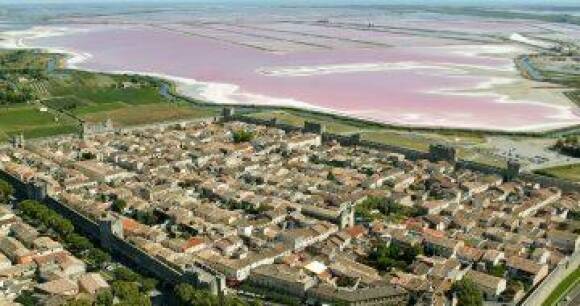
 Monument
Monument
Aigues-Mortes
This fortified town was built by Louis XIV in the 13th century. Its most significant monument is the Tower of Constance, which in times gone by served as a state prison.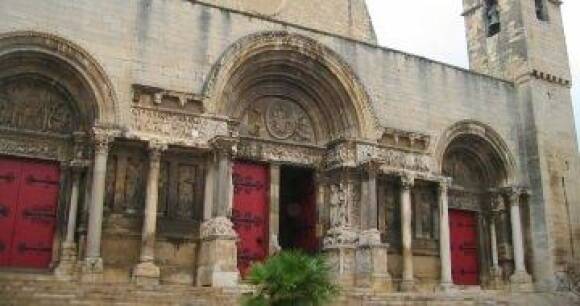
 Monument
Monument
Saint Gilles
The Abbey of Saint-Gilles dates back to the 10th century. This former Benedictine monastery has been one of the designated UNESCO World Heritage Sites of the Routes of Santiago de Compostela in France since 1998. Monument
Monument
Tour des Remparts
Walk along the medieval ramparts and take the walkway for a panoramic view of the Camargue. Admire the panorama over the pink waters of the famous salt flats from the southern rampart. Monument
Monument
La Grande-Motte
Designed in the 1960s by architect Jean Balladur, La Grande Motte is a seaside resort famous for its unique pyramid-shaped architecture. The town offers several kilometers of fine sandy beaches, a modern marina, and various water activities. A popular tourist destination, La Grande Motte attracts visitors with its summer atmosphere, festivals, and events throughout the year. Monument
Monument
L’Abbatiale de Saint-Gilles
Explore this 12th-century abbey, listed as a UNESCO World Heritage Site. Admire the sculpted façade, a masterpiece of Romanesque art, featuring a frieze dedicated to the Passion of Christ. And finally, discover the monumental crypt that houses the tomb of Saint Giles. Nature
Nature
Salin d’Aigues-Mortes
Take a small train excursion to the Salin d’Aigues-Mortes to discover the salt production process of the Camargue. Learn about the formation of Camargue’s Fleur de Sel by visiting the salt pans’ crystallizers. Nature
Nature
the birds of Camargue
The Rhône delta, between Sète and Beaucaire, is a great location to see the birds of the Camargue: the pink flamingo, the common cuckoo, the Eurasian coot, the great crested grebe, the European bee-eater and the kingfisher, as well as the wild Camargue horses. Sports and leisure activities
Sports and leisure activities
Ponant Aventure
For thrill-seekers, explore the 10 treetop adventure courses at Ponant Aventure, featuring over 140 challenges between sky and sea. This park offers an exceptional view from the wooden masts, which reach nearly 25 meters high. Sports and leisure activities
Sports and leisure activities
The Big Blue
Spend a relaxing day at Le Grand Bleu water park. Enjoy the indoor and outdoor pools, water slides, hot tubs, and green spaces perfect for picnicking.From St Gilles to Bellegarde, 12 km, 0 Lock(s), 1.6 h of navigation

 Monument
Monument
Saint Gilles
The Abbey of Saint-Gilles dates back to the 10th century. This former Benedictine monastery has been one of the designated UNESCO World Heritage Sites of the Routes of Santiago de Compostela in France since 1998. Monument
Monument
L’Abbatiale de Saint-Gilles
Explore this 12th-century abbey, listed as a UNESCO World Heritage Site. Admire the sculpted façade, a masterpiece of Romanesque art, featuring a frieze dedicated to the Passion of Christ. And finally, discover the monumental crypt that houses the tomb of Saint Giles. Vineyard
Vineyard
the Clairette de Bellegarde
 Bike
Bike
Bike
Tow paths provide an ideal place to ride your bikeThe Locks
2 type(s) of lock(s) on The Canal du Midi- Automatic locks operated by boaters themselves, without a lock-keeper
- Automatic locks